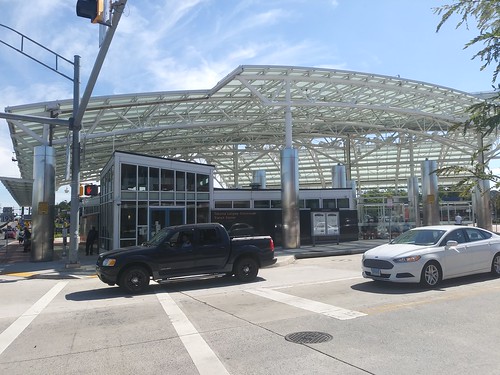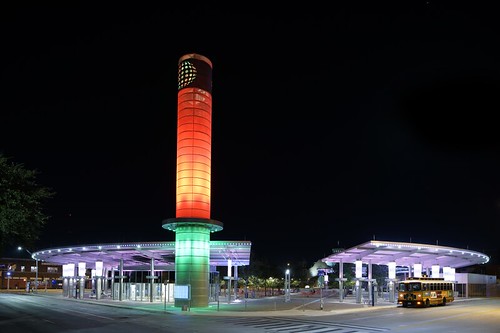Revisiting the review of the Takoma Langley Crossroads Transit Center
GGW has a post, "Poland’s “Unicorn Stable” tram station is dazzling and I want to nerd out with you about it," on the visually arresting "train shed" of the Piotrkowska-Centrum tram station in Łódź, Poland.


There isn't really much to update about the Takoma Langley Crossroads Transit Center from my supra-detailed review in December 2016.
 Item #6 concerned minimal bicycle accommodations. Now Prince George's County has joined Capital Bikeshare and there is a station there, as well as some stations between this area, the DC border, and College Park.
Item #6 concerned minimal bicycle accommodations. Now Prince George's County has joined Capital Bikeshare and there is a station there, as well as some stations between this area, the DC border, and College Park. Takoma Park installed a bike share station of its own behind the shopping center across the street, but in Montgomery County.
Item #17 addressed "Inadequate leveraging of the station to build and extend area identity."
Although I should have been more specific in the header about "transit infrastructure as an element of civic architecture."
With the saying that a picture is 1,000 words, the canopy design of the Piotrkowska-Centrum tram station is an exceptional illustration of the point and the lost opportunity to do something arresting.
It's all the more depressing, given all that Montgomery County and Prince George's County is investing in this area in terms of community revitalization, plus the fact that this will be a key station on the Purple Line light rail system.

It wouldn't be out of the question to go in and replace the glass, as well as to add a gateway sign (item #10), along the lines of the El Monte Station in Los Angeles County
or the Centro Chroma Tower in San Antonio, a public art installation by Bill FitzGibbons.

In my reviews of area transit stations, I've made the point that the DC and Baltimore area "metropolitan planning organizations" should produce jointly a guide to transit station design, so that the various misses as illustrated in my analyses of area stations can be reduced, and the station's opportunity to accomplish multiple objectives concerning transit marketing, civic design, and economic development simultaneously can be better achieved.
Labels: bicycle and pedestrian planning, bus stations, civic architecture, civic assets, integrated public realm framework, suburban revitalization, transportation infrastructure, urban design/placemaking



7 Comments:
Richard,
My concern is that a variety of people would want to keep the Takoma-Langley Transit Center utilitarian, from those who don't give a crap, to those who want to be sure it doesn't get too fancy and displace the poor.
It really feels like those who don't want to displace the poor are de facto setting up a dense suburban ghetto, to make sure the brown and poor people stay east of the park. I realize it sounds very cynical of me, but why else keep east county utilitarian while worry about pedestrian tunnels in Bethesda.
And, I agree there was a chance to make this station exceptional, given all of the bus and car traffic. I too am disappointed about the missed opportunities.
Well, wrt your first comment, yes, this is a thrust/thread in "equity organizing," that if you improve an area, it is a force for displacement, so it's better to let an area languish.
That's a tough issue. There is some truth to it. (This is an issue in the Columbia Pike corridor, with Empower DC and other activists in DC, suing developers, and even back in my H Street days, there was a sentiment expressed by some that if the area remains s***, sure it's s***, but at least it's ours, we won't face competition for it.)
My response is two-fold.
FWIW, my original thinking about the need for social infrastructure as a key element of equity planning and improving the lives of the less well off was simultaneously spurred by thinking about T-LC and East of the River (when I was on jury duty and figured out that much of the city's budget is spent merely on maintaining things the way they are for the impoverished, not in substantively improving their lives. FWIW/2, even though I get no credit for it, the DC position "Deputy Mayor for Greater Economic Opportunity" was basically my idea, which I discussed at great length with one of MB's campaign staff, although I had termed it DM for East of the River.
1. Be active in preserving affordability, build the social infrastructure to improve people's lives.
2. To be active, in the Takoma Langley context, it means creating a true CDC that can purchase property and hold it, build new stuff, fund work by others, etc.
Although I wrote about that in the context of the Purple Line more generally, for the entire catchment area.
http://urbanplacesandspaces.blogspot.com/2017/07/pl-6-creating-transportation.html
The problem T-LC has is it's split between two jurisdictions, and it needs to operate in a cross-border way. And in Maryland, outside of Baltimore City, there isn't a lot of examples of cities/counties being active developers. (And there are public involvement and disclosure issues with the Baltimore Development Corporation example.)
PGC isn't a leader in innovation. And there isn't the will in MoCo to do something like this, especially as the county is outsourcing more and more its economic development initiatives.
A few months ago I read the Long Branch sector plan in preparation for writing something I never wrote about creating a multifaceted community hub by rebuilding the library.
The sector plan reads fine, but it's very very general. So general that it doesn't do much. It needs some real specifics.
I haven't revisited this for awhile. At some point I should.
http://urbanplacesandspaces.blogspot.com/2017/12/an-outline-for-integrated-equity.html
When I first got involved in this stuff, I read a lot of community development literature, in part because DC's CDCs seemed so bad.
One of the books was _Streets of Hope_, which is about a CDC in Rosbury, Boston. They did a lot of great stuff, pioneered an urban land trust, got to take over vacant properties through eminent domain, etc. (That example scared me in terms of promoting it in DC because CDCs couldn't be trusted to use ED authority.)
The book came out in 1994. But 20+ years later, they control fewer than 300 units. The land trust isn't that big, etc.
But you can see how with Takoma Park's "New Ave." initiative and a CDC and the Purple Line and PG initiatives, how things could change reasonably remarkably.
You start by making a visually arresting bus station and doing all the things I said need to be done in the review.
You rebuild the Long Branch Library into a multi-faceted community hub.
You remake the business association for TLC into something better. They call themselves a "Development Authority" but they are really a business support organization, not even really a Main Street type group.
And at Long Branch, you come up with the money to seed development of an awesome mixed use project next to the LR station, along with multi-faceted hub.
But even my idea of a hub is confused because separately the County is helping to fund a hub center of some sort for CASA.
It should have been at the Library.
And Rockville and the SL libraries could have been an example.
====
FYI, some Saturday you should go to the Hyattsville core and check out the "hub" at Pyramid Atlantic Arts Center. It has a visitors center, plus Pyramid and all their facilities, a gallery, and space for the Neighborhood Design Center.
Imagine a space like that but on steroids, at the Long Branch Library, but with the functions of a Tower Hamlets Idea Store, a community organization hub, entrepreneurship development, etc.
SL is supposed to be Silver Spring
In re Roxbury (section of Boston), I'm embarrassed I lived in the City of Boston from 1995-2000. Okay, so I was a grad student, but I lived in the Fenway, definitely less than 2 miles from Roxbury. But, I was completely not thinking about local policies to address equity. However, when you describe empty lots as blight, I literally think of the gravel lots or abandoned parking lots I'd walk past on Park Drive or Boyleston Street. Maybe 5 years after I moved to Watertown MA, I'd go past those lots, since converted to apartments and offices, and marvel at how much more pleasant was the area.
As a resident of Takoma Park, I do hope TP's New Ave initiative helps out the businesses in the area. I'm not privy to the city's tax revenue sources, but that area is by far a majority of the commercial property in TP.
I do want to check out Hyattsville. Prince George's seems to be actively encouraging redevelopment of the Route 1-west of Rt 1 area. And, not too far away.
Post a Comment
<< Home